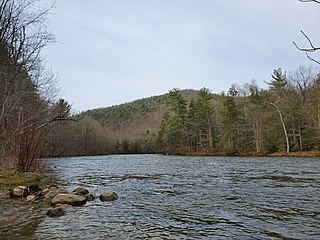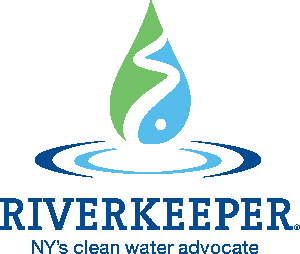Related Research Articles

Long Island Sound is a marine sound and tidal estuary of the Atlantic Ocean, lying predominantly between the U.S. state of Connecticut to the north, and Long Island in New York to the south. From west to east, the sound stretches 110 mi (180 km) from the East River in New York City, along the North Shore of Long Island, to Block Island Sound. A mix of freshwater from tributaries and saltwater from the ocean, Long Island Sound is 21 mi (34 km) at its widest point and varies in depth from 65 to 230 feet.
Waterkeeper Alliance is a worldwide network of environmental organizations founded in 1999, in response to a growing movement of organizations with such names as Riverkeeper, Baykeeper and Soundkeeper. By December 2019, the group said it had grown to 350 members in 46 countries, with half the membership outside the U.S.; the alliance had added 200 groups in the last five years.

The Housatonic River is a river, approximately 149 miles (240 km) long, in western Massachusetts and western Connecticut in the United States. It flows south to southeast, and drains about 1,950 square miles (5,100 km2) of southwestern Connecticut into Long Island Sound. Its watershed is just to the west of the watershed of the lower Connecticut River.

The Quinnipiac River is a 45.5-mile (73.2 km) long river in the New England region of the United States, located entirely in the state of Connecticut.

Robert Francis Kennedy Jr. is an American environmental lawyer and author known for promoting anti-vaccine propaganda and conspiracy theories. Kennedy is a son of U.S. senator Robert F. Kennedy and a nephew of President John F. Kennedy. He helped found the non-profit environmental group Waterkeeper Alliance in 1999 and has served as the president of its board. Kennedy has co-hosted Ring of Fire, a nationally syndicated radio program, and written or edited ten books, including two New York Times bestsellers.

The Hackensack River is a river, approximately 45 miles (72 km) long, in the U.S. states of New York and New Jersey, emptying into Newark Bay, a back chamber of New York Harbor. The watershed of the river includes part of the suburban area outside New York City just west of the lower Hudson River, which it roughly parallels, separated from it by the New Jersey Palisades. It also flows through and drains the New Jersey Meadowlands. The lower river, which is navigable as far as the city of Hackensack, is heavily industrialized and forms a commercial extension of Newark Bay. Once believed to be among the most polluted watercourses in the United States, it staged a modest revival by the late 2000s.

The Anacostia River is a river in the Mid Atlantic region of the United States. It flows from Prince George's County in Maryland into Washington, D.C., where it joins with the Washington Channel to empty into the Potomac River at Buzzard Point. It is approximately 8.7 miles (14.0 km) long. The name "Anacostia" derives from the area's early history as Nacotchtank, a settlement of Necostan or Anacostan Native Americans on the banks of the Anacostia River.

Riverkeeper is a non-profit environmental organization dedicated to the protection of the Hudson River and its tributaries, as well as the watersheds that provide New York City with its drinking water. It started out as the Hudson River Fisherman's Association (HRFA) in 1966. In 1986, the group officially changed its name to Riverkeeper, making it the first "keeper" group to be founded. In 1999, the Waterkeeper Alliance was created as an umbrella organization to unite and support "keeper" organizations.

The Maritime Aquarium at Norwalk is an aquarium located in the South Norwalk section of Norwalk, Connecticut.
Chattahoochee Riverkeeper (CRK) -- formerly known as Upper Chattahoochee Riverkeeper (UCR) -- is an environmental advocacy organization with 10,000 members dedicated solely to protecting and restoring the Chattahoochee River Basin. CRK was modeled after New York’s Hudson Riverkeeper and was the 11th licensed program in the international Waterkeeper Alliance. In 2012, the organization officially changed its name to simply Chattahoochee Riverkeeper (CRK), dropping the "Upper" to better reflect its stewardship over the entire river basin.

The Still River is a 25.4-mile-long (40.9 km) tributary to the Housatonic River in western Connecticut.
San Francisco Baykeeper is a nonprofit environmental advocacy organization that works to protect, preserve, and enhance the health of the ecosystems and communities that depend upon the San Francisco Bay. Since 1989, Baykeeper has stood guard over the waters of the San Francisco Bay-Delta Estuary and its watershed. These waters, in addition to their recreational value and biological productivity, also provide drinking water for more than 23 million people and serve as the cornerstone of California's economy. Beginning in the high reaches of the Sierra Nevada and Cascade Mountains, the Bay-Delta watershed encompasses the entire Bay Area and the Great Central Valley of California. This vast watershed includes virtually all of the state's remaining coastal wetlands and provides rare and fragile habitat for marine mammals, migrating birds, and California's few remaining endangered salmon runs.
Terry Backer, born Terrance Eddy Backer, was an American politician who served in the Connecticut House of Representatives from 1993 until his death in 2015.
Alex Matthiessen is an environmentalist and lives in New York City. He is the son of author and naturalist Peter Matthiessen.
Ash Creek is a tidal creek and intertidal wetland in Fairfield County, Connecticut that serves as a border between the city of Bridgeport and the town of Fairfield. It is the last salt water estuary in the area, extending from Long Island Sound and up the Rooster River.

Nutrient pollution, a form of water pollution, refers to contamination by excessive inputs of nutrients. It is a primary cause of eutrophication of surface waters, in which excess nutrients, usually nitrogen or phosphorus, stimulate algal growth. Sources of nutrient pollution include surface runoff from farm fields and pastures, discharges from septic tanks and feedlots, and emissions from combustion. Raw sewage is a large contributor to cultural eutrophication since sewage is high in nutrients. Releasing raw sewage into a large water body is referred to as sewage dumping, and still occurs all over the world. Excess reactive nitrogen compounds in the environment are associated with many large-scale environmental concerns. These include eutrophication of surface waters, harmful algal blooms, hypoxia, acid rain, nitrogen saturation in forests, and climate change.

The Pequonnock River is a 16.7-mile-long (26.9 km) waterway in eastern Fairfield County, Connecticut. Its watershed is located in five communities, with the majority of it located within Monroe, Trumbull, and Bridgeport. The river has a penchant for flooding, particularly in spring since the removal of a retention dam in Trumbull in the 1950s. There seems to be a sharp difference of opinion among historians as to just what the Indian word Pequonnock signifies. Some insist it meant cleared field or open ground; others are sure it meant broken ground; while a third group is certain it meant place of slaughter or place of destruction.

Gail Lavielle is a former member of the Connecticut House of Representatives, where she represented the 143rd district. The district included parts of Wilton, Norwalk, and, following redistricting in 2012, Westport. Representative Lavielle, an Assistant House Minority Leader, was the House Ranking Member of the Connecticut General Assembly's Appropriations Committee, and served on the Transportation and Education Committees. During her 10 years in the legislature, she also served on the Finance, Revenue, and Bonding Committee and Higher Education Committee and as House Ranking Member of both the Education Committee and the Commerce Committee.

Potomac Riverkeeper Network is an environmental, registered non-profit organization based in Washington, D.C. that is dedicated to protecting the Potomac River and its tributaries. As a "riverkeeper" organization, it is a member of the umbrella organization Waterkeeper Alliance.

Between 1947 and 1977, General Electric polluted the Hudson River by discharging polychlorinated biphenyls (PCBs) causing a range of harmful effects to wildlife and people who eat fish from the river. Other kinds of pollution, including mercury contamination and cities discharging untreated sewage, have also caused problems in the river.
References
- ↑ Long Island Sound – Soundkeeper
- ↑ C.O.N.C.O.R.D
- ↑ Long Island Sound – Soundkeeper Archived 2007-08-08 at the Wayback Machine
- ↑ Long Island Sound – Soundkeeper Archived 2007-09-27 at the Wayback Machine
- ↑ Long Island Sound – Soundkeeper Archived 2007-08-08 at the Wayback Machine
- ↑ Long Island Sound – Soundkeeper Archived 2007-08-08 at the Wayback Machine
- ↑ Fairfield JD Directions
- ↑ Waterkeeper Alliance
- ↑ Welcome to the Division of Corporations Archived 2007-08-29 at the Wayback Machine